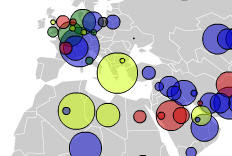Job Losses in New York City Documented by Subway Ridership Map
The New York Times has created an interactive map showing the gains or losses in subway ridership over the past year. The maps shows a graduated symbol on each subway stop and provides a tool tip indicating the stop, the increase or decrease in ridership and the number of average daily riders. Most striking, as pointed out in the article, is how you can map the areas hit hardest by the economic recession. It should serve as an invaluable tool for the NYC transportation authority as well as urban planners. But, unfortunately, it displays the tragic effects of a job losses and the potential impact upon the individual local economy around each subway stop.
